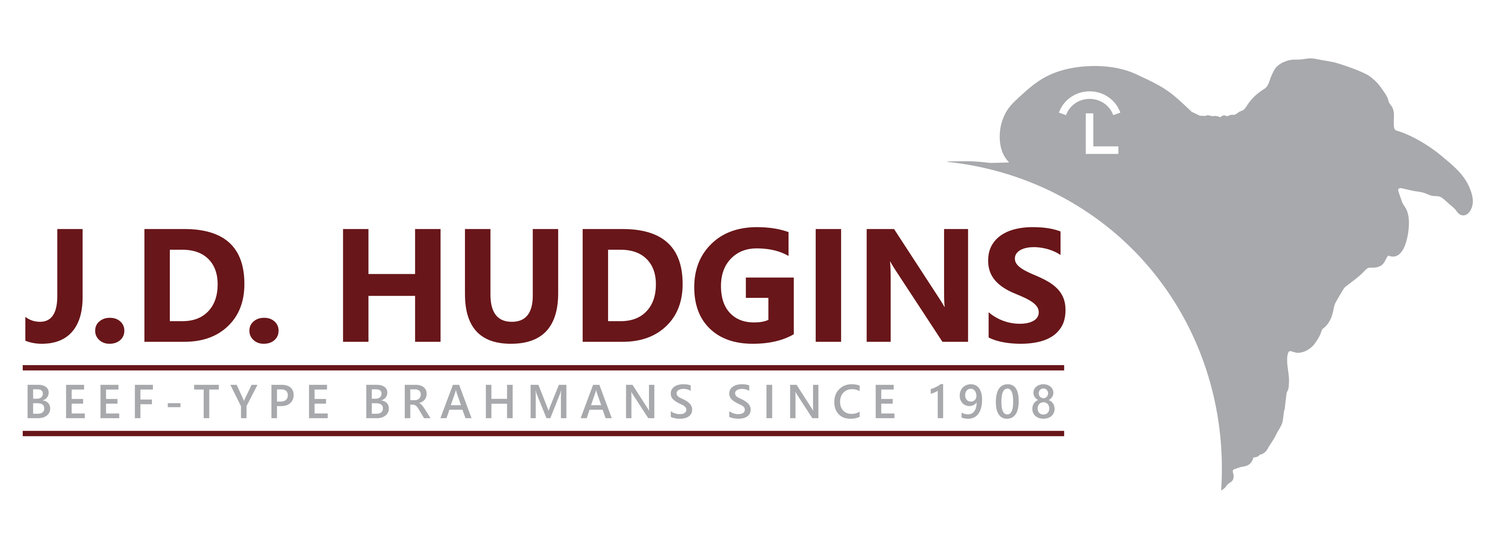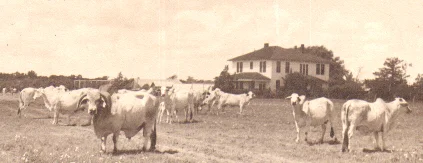The Manso-bred cattle set the standard of quality that became the trademark of the brand. Walter Hudgins went to Francitas, Texas, in 1933 and saw Manso for the first time. He was very impressed with the bull’s type, conformation, size and disposition. He traded Mrs. Gayle five young bulls for Manso. Walter Hudgins, Edgar Hudgins and Carlton Hudgins went to pick up Manso in a Model A Ford truck equipped with a homemade cattle rack. Mrs. Gayle had no loading facilities. An improvised chute was made with gates, and they backed the truck up to it and loaded the bull. A halter was put on Manso even though he was not halter-broken. They tied his head down to the floor of the truck to keep him from jumping out. The Hudgins group started home late in the afternoon, and by nightfall they were just at El Campo. The lights failed on the truck, and the last 20 miles to Hungerford were made in the dark, at a very slow pace, with Carlton riding on the front fender trying to see any stray cattle that might be on the road.
Manso was put with his first breeding herd on the J.D. Hudgins Ranch in the "Kecura" pasture Fall of 1933. During the first few weeks that Manso was with his herd of cows, no one ever saw him work a cow, and Walter Hudgins became apprehensive. He even hired Calvin Davis, a retired farmer, to observe the bull to see if he was working. This was long before any permanent veterinarians were living in Wharton County, and no one had ever thought about fertility-testing bulls, as there was no equipment in existence in the area for that purpose. After about 60 days of observation without any visible results, Calvin Davis said the bull was no good. However, Walter Hudgins concluded that the bull must be good, as he did not see many cows cycling.
Manso proved to be an excellent and very prolific sire. His first calves were born in the Fall of 1934, and many cattlemen saw them and offered to buy the bull calves directly off their mothers at $100 each. During this time, grown, unregistered, Brahman-type cross cows with calves at their sides were bringing only $10 per pair, as this was in the depths of the world-wide depression.
It was fortunate that Manso came into the Hudgins’ possession at this particular time, as they badly needed a heavy-muscled bull to mate with their crosses of the Brazilian bulls on the Nellore cows during this stage of developing their herd. There were granddaughters of the Brazilian bulls available for this mating, and they were much superior to the Nellore cows that Hudgins had started with in 1915. Had Manso come into the Hudgins herd in the early 1920’s, his influence would not have been so profound. Since Manso was a very thick, heavy set, fleshy, large and docile bull, he made an immediate imprint on his offspring, as the early Brahman cattle were very leggy, wild, narrow-bodied, and lacked fleshing ability. He had a very good head with much width between the eyes, although he was not short-headed as were British cattle. He had horns that turned down by the side of his head which were commonly referred to as “banana horns.” Manso had sound feet and legs, moderate sheath, and was steel gray in color. He was especially wide over his shoulders, right behind his hump, where many Brahman cattle of that era were usually pinched in the heart girth and narrow. His loin was broad and deep, his depth of body was good. Manso had a straight underline with a deep flank and a straight topline, and he was well muscled in the hind quarter, carrying his width from his hip to his pin bones very evenly. He was wide, deep and thick in the twist with a slightly rounding rump that was very broad. Manso weighed one ton when he was fat. He was never halter-broken and never shown.
At the time of his death in 1943 at the age of 17 years, Manso had produced 316 offspring for the ranch. It has been estimated that over 75% of all cattle registered by the American Brahman Breeders Association carry Manso breeding. Manso is seen in the picture on the top of this page.



